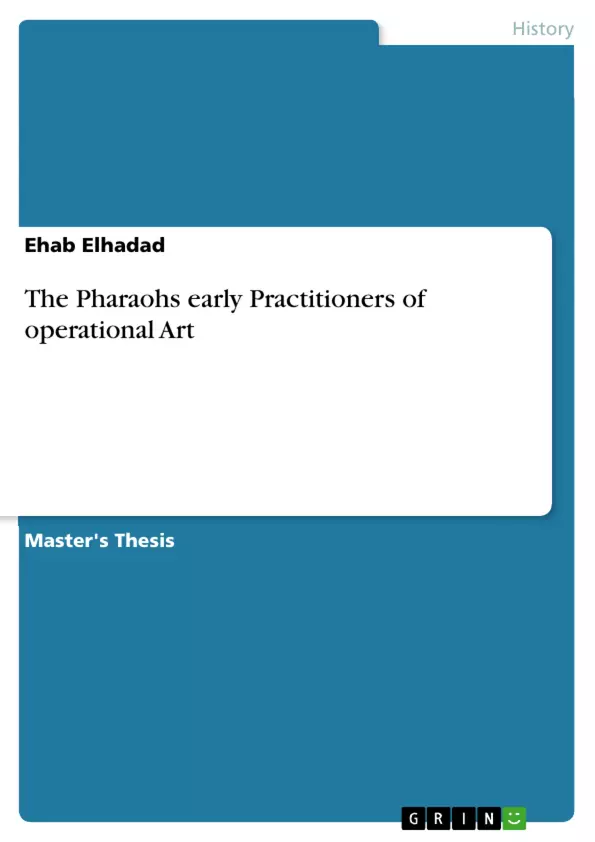This research suggests that the Egyptian Pharaohs during the New Kingdom applied operational art. Accordingly, theoreticians and practitioners should date the origins of operational art at least as early as Ancient Egypt. The significance of this study is paramount, as it expands the boundaries of military history by showing that the origins of operational art do not lie exclusively within nineteenth century military conflicts in Europe and America. Additionally, it proves that operational art is a timeless phenomenon and will continue to evolve and withstand the changing conditions of future warfare. Instead of relating operational art to a specific country, military scholars should put the pieces of the operational paradigm together, starting from the early beginning to the modern times.
Man’s history in the lands of the Nile extends back to the dawn of humankind and is one of the possible locations where man first crossed the line from indiscriminative violence to organized warfare. However, military historians ignore ancient Egyptians’ contribution to military art and science by relating the origins of operational art to European and American practitioners of the nineteenth century.
Did the ancient Egyptian military reached a high level of sophistication, and did it practice operational art as conceived by modern military theorists during the New Kingdom of the Early Bronze Age (1550–1070 B.C.)? This work makes the case that operational art emerged during that period. This study explains how Ancient Egypt’s war machine reached a high level of sophistication through a brief examination of Ancient Egypt warfare. It then examines the Pharaohs’ campaigns in the Asiatic theatre using operational factors and elements as discussed within the current U.S. Army doctrine.
Inhaltsverzeichnis (Table of Contents)
- INTRODUCTION.
- Historical and Geographical Scope....
- LITREATURE REVIEW.
- On Operational Art
- Ancient Egyptian Military.
- METHODOLOGY.
- THE PHARAOHS' WARFARE
- Key Campaigns of the New Kingdom.
- Thutmose III's Campaigns....
- Sety I's Yenoam Campaign.
- Ramses II's Kadesh Campaign.
- Analysis of Operational Factors.
- The Factor of Time
- The Factor of Force
- Analysis of Operational Elements.
- Endstate and Conditions
- Center of Gravity
- Decisive Points
- Operational Reach
- Basing
- Sequential and Simultaneous Operations
- Phasing...
- Culmination.
- Risk.....
- The evolution of ancient Egyptian military practices and their sophistication during the New Kingdom.
- The application of operational art principles in the campaigns of Pharaohs during the New Kingdom.
- The significance of the Egyptian Pharaohs' contributions to operational art, expanding the historical understanding of its origins.
- The enduring nature of operational art as a timeless phenomenon, adapting to changing warfare conditions throughout history.
- The importance of recognizing the contributions of ancient civilizations like Egypt to the development of military strategy and operational art.
Zielsetzung und Themenschwerpunkte (Objectives and Key Themes)
The primary objective of this monograph is to demonstrate that the ancient Egyptian Pharaohs during the New Kingdom, specifically from 1550 to 1070 B.C., practiced operational art. The monograph challenges the conventional view that operational art emerged solely in the nineteenth century within European and American military contexts. It examines the campaigns of notable Pharaohs such as Thutmose III, Sety I, and Ramses II, analyzing their military strategies and tactics through the lens of modern U.S. Army operational art doctrine.
Zusammenfassung der Kapitel (Chapter Summaries)
The Introduction sets the historical and geographical scope of the study, highlighting the enduring significance of the Nile Valley in human history and its potential as a cradle for organized warfare. The Literature Review delves into existing scholarship on operational art, focusing on its theoretical foundations and the perceived origins of its practice. It also provides an overview of the ancient Egyptian military, its organization, and its early development.
The Methodology chapter outlines the research methods employed in the study. The chapter "THE PHARAOHS' WARFARE" examines the military campaigns of the New Kingdom, specifically focusing on the campaigns of Thutmose III, Sety I, and Ramses II. Each campaign is analyzed in detail, examining the strategic decisions, tactics, and operational considerations employed by the Pharaohs. The analysis of these campaigns then delves into the application of operational factors and elements as defined in U.S. Army doctrine. These include the factors of time and force, as well as elements like endstate and conditions, center of gravity, decisive points, operational reach, basing, phasing, culmination, and risk.
Schlüsselwörter (Keywords)
This monograph utilizes key terms and concepts related to operational art, ancient Egyptian warfare, the New Kingdom, military history, campaign analysis, strategic decision-making, operational factors, operational elements, and the historical origins of military strategy.
- Quote paper
- Ehab Elhadad (Author), 2023, The Pharaohs early Practitioners of operational Art, Munich, GRIN Verlag, https://www.grin.com/document/1397463



